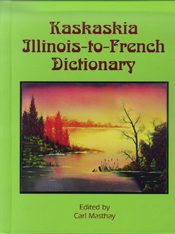
Ladyslipper Press
Native Literatures
For about 300 years a major, overwhelmingly dense document in an Algonquian language now identified as “Kaskaskia Illinois” remained unworked on and thus unpublished so as to be usable…

For about 300 years a major, overwhelmingly dense document in an Algonquian language now identified as “Kaskaskia Illinois” remained unworked on and thus unpublished so as to be usable. It was first found in the early 1800s by Monsignor Rosati of St. Louis and was acquired later in that century by James Hammond Trumbull, who attempted to transcribe it. The original document is a monster in size at 580 pages as well as in legibility, with many cramped words and interlinear additions and overwritten deletions. The language of translation is French with a heavy sprinkling of obscure words. The manuscript is preserved now in the Watkinson Library of Trinity College in Hartford as if it were Father Jacques Gravier who had compiled it. Perhaps he did, but handwriting evidence points to three compilers but now determined to be Jacques Largillier, dit “le Castor” (“Beaver”), circa 1634 to 4 November 1714 (per Michael McCafferty 2006).
Carl Masthay, Ph.D. has now edited the entire work for easy readability and provided translations for all the obscure words or phrases with the necessary assumption that a user has already studied at least a year of French. The large index to the work provides access to all the words to the original dictionary. Masthay, a Chinese translator in the U.S. Air Force in the early 1960s, and a retired medical manuscript editor at Mosby, Inc., for 33 years, began early study of Algonquian languages stimulated by place-name study, culminating in a 47-page monograph on Mahican-language hymns (1980) and 11 years of work on his 200-page Schmick’s Mahican Dictionary, published by the American Philosophical Society in 1991.
“Carl Masthay is back. After spending 11 years working on his Schmick’s Mahican Dictionary (which was reviewed a while back), he’s now spent another 12 years on this work…. it’s more than a dictionary, as the culture of a civilization is revealed through its language. Besides the 278 pages of the dictionary and the 431-page index, there are interesting side articles about the history of this vanished tribe, an account of an alleged fabrication known as the Tamaroa remnant, and collections of maledicta, superstitions, and biblical allusions (they were visited by Jesuit priests at one time).”
Tom Elliott
Mensa Bulletin [March 2003, No. 463, p. 24]“…magnificent…[Masthay seems] to have thought of everything with all these little side remarks on abbreviations, odd French words.”
John R Krueger, Ph.D.
Professor of Turkic and Mongolian languages, Indiana University“…an incredible undertaking…Personally, I find it helpful and use it quite often….”
Daryl Baldwin
(Baldwin is an Ohio and Indiana Miami who is reviving his ancestral language with the help of David Costa)
“The Kaskaskia Illinois–to–French Dictionary is Carl Masthay’s second redaction of a historic Algonquian manuscript dictionary. This time he has accomplished the Herculean task of re-transcribing the enormous and tremendously dense three-hundred-year-old five-hundred-and-eighty page Illinois-French dictionary commonly attributed to the Jesuit missionary Jacques Gravier. The original manuscript, housed at the Watkinson Library, is available on microfilm. However, Masthay has made the work instantly accessible to the linguist, historian, anthropologist and anyone interested in the historic Illinois Indians, the Illinois language, and the French language spoken in the Mississippi valley in the late 17th and early 18th centuries.”
Michael McCafferty (Indiana University) and Robert Vézina (Université Laval)
Algonquian and Iroquoian Linguistics [27(4):48, Winter 2002]
“Carl Masthay’s dictionary is one of the most important contributions to the Algonquian literature to appear in the last few years, especially from the point of view of a linguistic anthropologist. It is a massive work, which, I estimate, contains about 23,000 Illinois words, and reflects the early historical period when French missionary linguists were active.”
P. Proulx
Anthropological Linguistics [44(4):417-418, Winter 2002]
“Masthay has successfully raised this linguistic treasure and made it accessible to the scholarly world. Moreover he has renounced translating all French translation of it once again into English—solely unusual words that can be misunderstood, certain transcriptions, and garbled phrases were provided with English explanations. Also errors or defects were removed by him in his painstaking edition. Furthermore he evened out the heavily religious and biblical allegories that the genius of the Illinois language distorted. Wherever he evaluated the many other sources, he ventured, in addition, to propose significant supplements, some concerns such as modes of expression, phrases, double meanings, and supernatural circumlocutions. In any case he indicates that the user of this dictionary must have at least a basic knowledge of French so as to be able to work with it successfully.
What Masthay has done is simply insufficient to put into words. It is not only the preservation, it is—at least in the conveyed meaning and in the sense of ethnohistorical research—the reflected documentation of a language. Whoever is involved with Algonquian ethnic groups in a scholarly manner will in the future no longer get along without this work. This is of course valid also for linguists, historians, theologians, as well as ethnologists and anthropologists. With this book at hand, they have a tool of inestimable value that would help to reconstruct and to understand buried elements of Algonquian culture. A scholarly monument whose significance cannot be assessed highly enough.”
Dietmar Kuegler
Magazin für Amerikanistik, Wyk auf Foehr, Germany (translated by Carl Masthay)

Ladyslipper Press